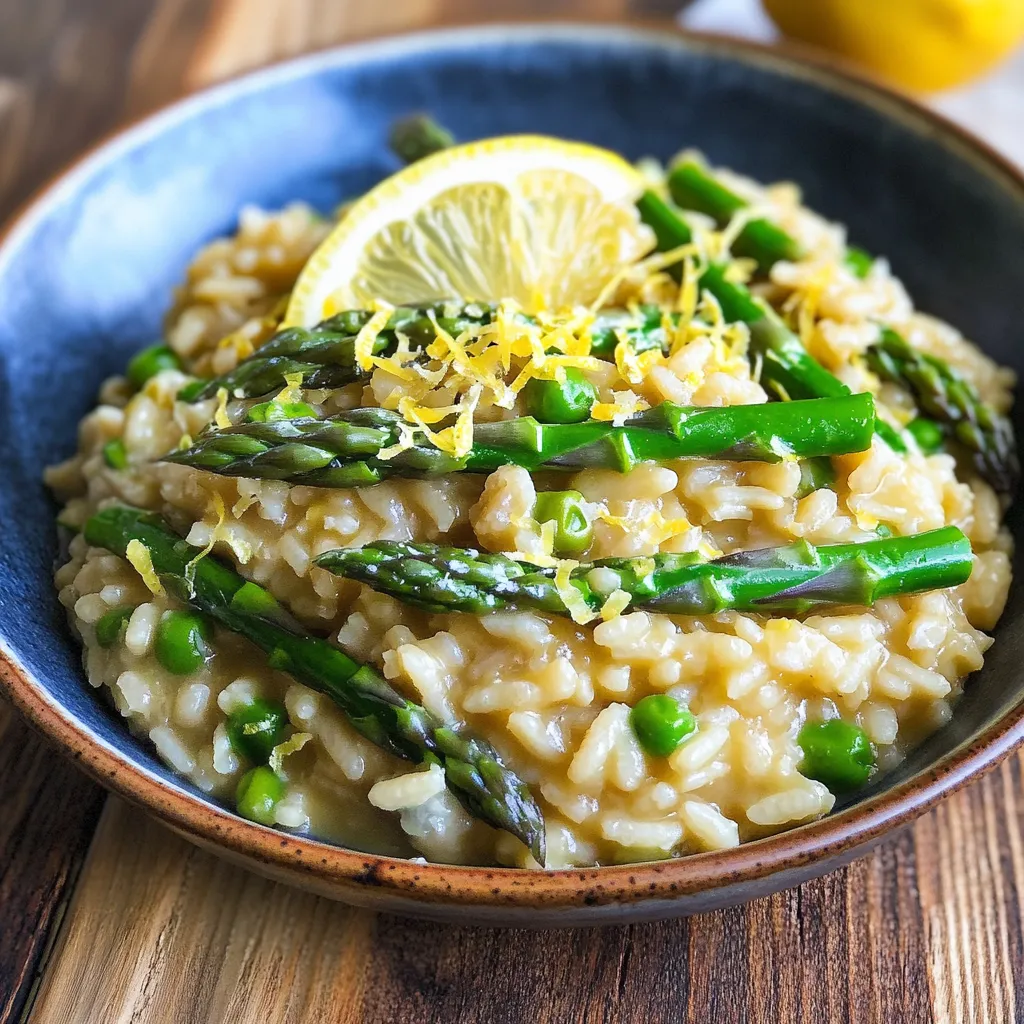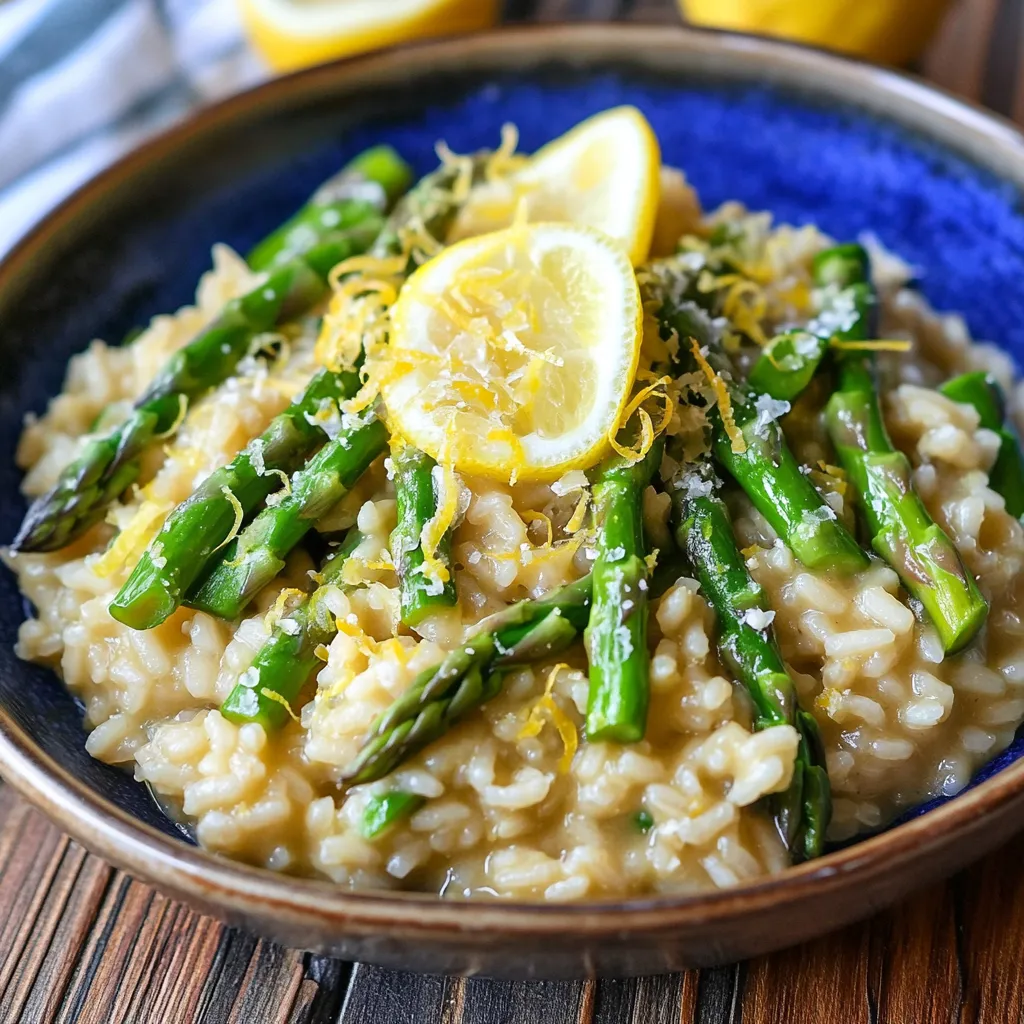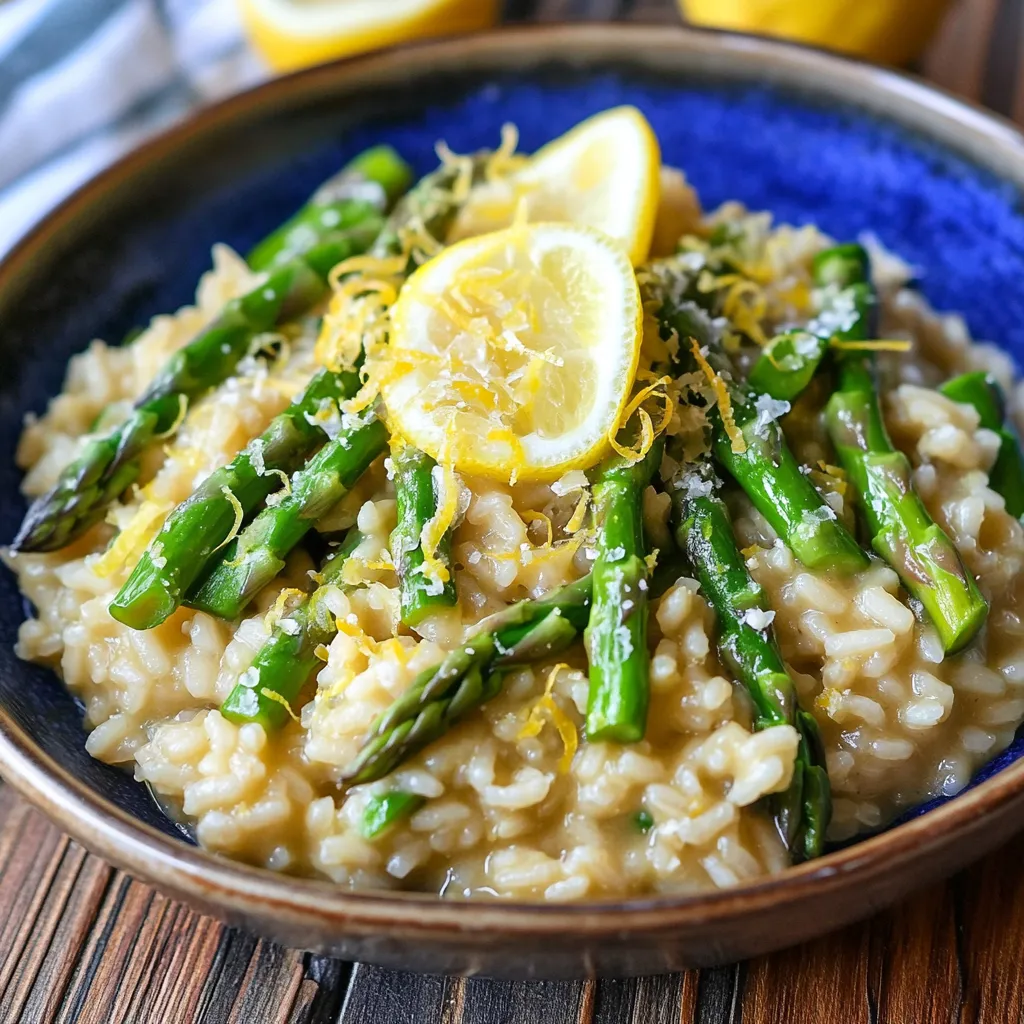 Pin it
Pin it
This asparagus lemon risotto transforms simple ingredients into a luxurious dish that tastes like spring in a bowl. The bright citrus notes perfectly complement the earthy asparagus, creating a balanced dish that feels sophisticated yet comforting.
I first made this risotto for a dinner party where I wanted to impress without spending hours in the kitchen. Now it's become my signature dish whenever asparagus is in season, and friends always request the recipe after trying it.
Ingredients
- Asparagus: One bunch provides the perfect amount of fresh flavor and color. Look for medium thickness stalks with tight closed tips
- Unsalted butter: Combined with olive oil creates the perfect base. Using unsalted lets you control the seasoning
- Extra virgin olive oil: Use a good quality one for better flavor in this simple dish
- Onion: The aromatic foundation of any good risotto. Choose a sweet variety like Vidalia if available
- Arborio rice: Essential for authentic risotto. The high starch content creates that signature creamy texture
- Dry white wine: Adds acidity and depth. Chardonnay works beautifully but any dry white will do
- Vegetable stock: The liquid that transforms the rice. Homemade is best but a quality store bought works well
- Parmesan cheese: Adds richness and saltiness. Buy a block and grate it yourself for best results
- Lemon: Both juice and zest brighten the entire dish. Choose organic if possible since you're using the zest
- Salt and pepper: Simple seasonings that enhance everything else
Step-by-Step Instructions
- Cook the Asparagus:
- Prepare asparagus following the Perfect Asparagus recipe until tender but still bright green. Allow to cool slightly before cutting into two inch pieces. The asparagus should maintain some texture as it will cook a bit more when added to the risotto.
- Create the Base:
- In a medium heavy bottomed saucepan combine butter and olive oil over medium high heat until the butter melts completely. Add the diced onion and sauté for a full 5 minutes until they become translucent but not browned. This creates a sweet foundation flavor.
- Toast the Rice:
- Add the Arborio rice to the onion mixture and stir constantly for 2 to 3 minutes. This crucial step coats each grain in fat and begins to toast the exterior. Watch for the rice to become slightly golden around the edges which enhances the nutty flavor of the finished dish.
- Begin the Liquid Additions:
- Pour in the white wine all at once and allow it to bubble vigorously. Stir constantly until almost all the liquid has been absorbed into the rice. This deglazes the pan and adds bright acidity to the dish.
- Develop the Creamy Texture:
- Add vegetable stock a quarter cup at a time stirring constantly between additions. Wait until most but not all of the liquid is absorbed before adding more. Maintain a medium simmer throughout this process. The stirring releases starch and creates the signature creamy texture without adding cream.
 Pin it
Pin it
Arborio rice is the magic ingredient that makes this dish special. I learned from an Italian chef that the constant stirring releases the starch molecules that give risotto its signature texture. While it requires some attention at the stove, the meditative quality of stirring makes this one of my favorite dishes to prepare when I want to unwind after a long day.
Can I Make This Ahead?
Risotto is best enjoyed freshly made, but you can prepare components ahead of time. Cook the asparagus and measure out all ingredients earlier in the day. For completely made ahead risotto, reheat gently on the stove with a splash of stock, stirring frequently until warmed through. The texture will be slightly less creamy but still delicious.
Customizing Your Risotto
This recipe welcomes variations based on what you have on hand. Swap asparagus for green peas or artichoke hearts in different seasons. Add cooked chicken or shrimp for a protein boost. For a vegan version, use olive oil instead of butter and substitute nutritional yeast for the Parmesan. The technique remains the same with any variation.
Perfect Pairings
Serve this bright risotto with a simple green salad dressed with lemon vinaigrette for a complete meal. For wine, continue with the same dry white used in cooking or try a crisp Sauvignon Blanc that echoes the lemon notes. A light bodied Pinot Grigio also complements the delicate flavors without overwhelming them.
 Pin it
Pin it
This risotto is a delicious way to welcome spring flavors into your kitchen, and it's sure to become a timeless classic in your recipe collection.
Frequently Asked Questions
- → Can I use frozen asparagus instead of fresh?
While fresh asparagus provides the best texture and flavor, frozen asparagus can work in a pinch. Thaw completely and pat dry before adding to avoid excess moisture. Note that frozen asparagus is pre-blanched, so you'll want to add it at the very end of cooking just to warm through.
- → What can I substitute for white wine?
If you prefer not to use wine, substitute with an equal amount of vegetable stock plus 1 tablespoon of fresh lemon juice to mimic the acidity. You can also use white grape juice with a splash of white wine vinegar as an alcohol-free alternative.
- → Can I make this risotto ahead of time?
Risotto is best served immediately after cooking for the ideal creamy texture. However, you can partially make it ahead by cooking until it's about 75% done, then cooling and refrigerating. When ready to serve, bring it back to temperature with additional warm stock and finish the final cooking stage.
- → Is arborio rice necessary or can I use another type?
Arborio rice is traditional for risotto because its high starch content creates the creamy texture. Other short-grain rice varieties like Carnaroli or Vialone Nano work well too. Regular long-grain rice won't produce authentic results as it lacks the necessary starch.
- → How do I know when the risotto is properly cooked?
Perfectly cooked risotto should be al dente (tender but with slight resistance when bitten) and creamy, not mushy or soupy. The grains should still maintain their individual structure. If you draw a spoon through the risotto, it should slowly flow back together.
- → Can I add other vegetables to this risotto?
Absolutely! This risotto works beautifully with additions like peas, mushrooms, or zucchini. Add firmer vegetables during the cooking process and more delicate ones toward the end. Just be mindful of moisture content as some vegetables may release water that affects the consistency.
